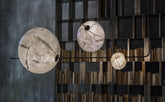HENGE: THE ALCHEMICAL ABILITY TO TRANSFORM MATTER
Research on materials, contemporary design and craftmanship. These three concepts sum up Henge – a young company from Veneto that is already a symbol of Made in Italy through out the world.

Contact Us
book a visit
Location
Research on materials, contemporary design and craftmanship. These three concepts sum up Henge – a young company from Veneto that is already a symbol of Made in Italy through out the world.

Founders Paolo Tormena, interested in rare materials and processes, and Massimo Castagna, architect and creative director of the brand, wanted to create a project capable of expressing the excellence of Italian know-how. The brand's name is inspired by Stonehenge, an ancient archaeological site bearing witness to the ancestral connection between man and matter. Matter is the absolute protagonist of Henge: a real, authentic and brutal matter, exasperated in its expression. Metal, wood, stone and glass: Henge selects premium materials from all over the world. Unique materials are chosen because they have a story to tell.
Such as the Breccia Medicea dell'Acqua Santa, a stone used by the Medici to build the holy water fonts in churches and found in a small quarry in Tuscany. Or the Olive Swamp wood, dating back to 421 A.D., with its ancient/millennial beauty. Or again Forest Fusion—not exactly a root but the part of the tree between the root and the trunk, that is normally considered waste. A process almost forgotten that was recovered by Henge to create several products in its collection.
In Henge’s designs, the rare materials are combined with craftsmanship. Skills that have often been forgotten or have fallen into disuse. “We are lucky,” says Castagna, “to have an artisan heritage of such a high level, which is able to apply extremely specific techniques. In artisan workshops, we can find incredible things that industry, by its nature, cannot use. An almost alchemical ability to transform matter”.
Henge relies on a network of local workshops. Its secret is to bring back the memory of techniques and processes that have all but disappeared and to track down the last craftsman still capable of performing them: a recovery that has not only technical but also cultural value.
This approach brings objects to life that are more than pieces of furniture. They are life companions we can build intimate and personal relationships with, objects that reflect an idea of beauty and are designed to last.